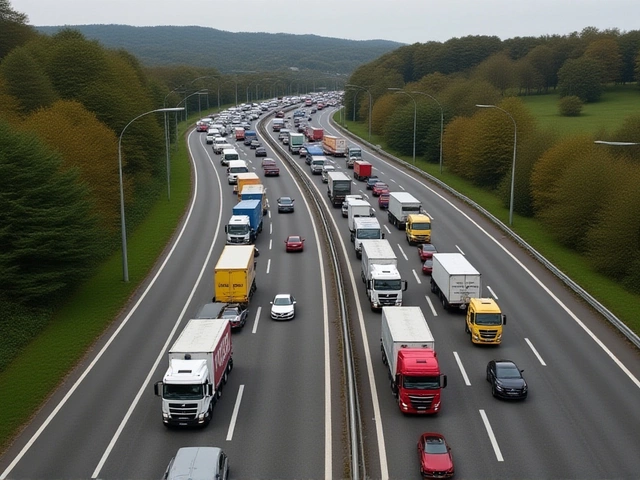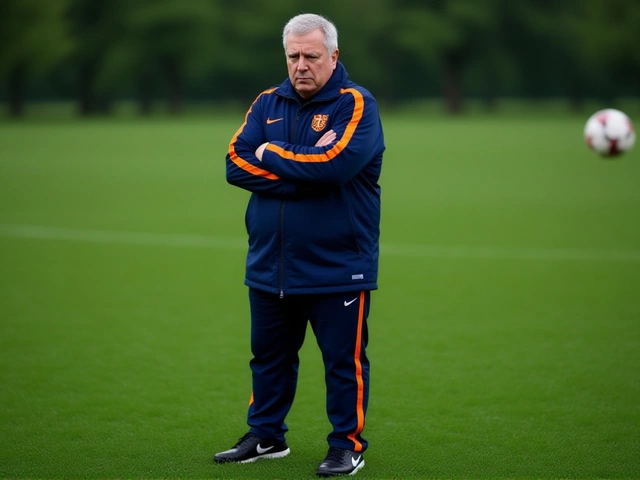At 4:41 a.m. on Thursday, October 30, 2025, the quiet pre-dawn stillness near Heathrow Airport shattered as a car and a lorry slammed into each other on the M25’s clockwise carriageway at Junction 14. One man was trapped. Firefighters arrived within minutes. By 6:23 a.m., he was free — alive, but rushed to hospital. The M25, Britain’s busiest ring road, was shut. And for hours, thousands of commuters, freight drivers, and airport transfers were stranded in a gridlock no one saw coming.
How a 4 a.m. crash paralyzed London’s motorway ring
The collision happened just after 4 a.m., when traffic on the M25 is typically light — but not empty. Trucks heading to Heathrow’s cargo terminals, early shift workers, and overnight delivery vans still roll through this stretch. The impact between a passenger car and a heavy goods vehicle left the car crumpled around its driver. Firefighters from Hayes Fire Station, part of the London Fire Brigade, responded immediately. Mutual aid came from Surrey Fire & Rescue Service, whose jurisdiction borders Hillingdon. Together, they worked for 1 hour and 42 minutes to free the man using hydraulic tools and extrication techniques refined over decades of motorway crashes.There were no other injuries. No explosions. No fire. Just one man, one vehicle, and a motorway that stopped.
Who managed the chaos — and who didn’t
The London Fire Brigade handled rescue. National Highways, the government body that manages England’s trunk roads, took over traffic control. They slammed the brakes on the entire clockwise lane, closing it completely. Slip roads were redirected. Variable message signs flashed warnings from Uxbridge to Staines. No one was spared.By 6:23 a.m., the firefighters left. Responsibility shifted. The Metropolitan Police Service began its investigation. They’d need to determine speed, road conditions, driver fatigue, vehicle maintenance — all the usual suspects in a crash this serious. But here’s the thing: no names were released. Not the driver’s. Not the lorry operator’s. Not even the hospital he was taken to.
It’s not unusual. Privacy rules shield victims. But it leaves the public guessing. Was he a delivery driver? A taxi operator? A local resident rushing to work? We don’t know. And that silence speaks volumes.

Why this crash matters more than most
The M25 isn’t just a road. It’s the circulatory system of southern England. Over 200,000 vehicles use this stretch daily. Heathrow Airport, just 1.5 miles away, relies on it for 80% of its freight. Airlines, logistics firms, even the NHS — they all depend on this corridor.When it shuts, ripple effects explode. Delays at cargo terminals. Missed flights. Late hospital deliveries. Packed A40s and A312s as drivers flee the closure. One crash. Hundreds of missed appointments. Thousands of lost hours.
National Highways said they provided "ongoing updates." But updates don’t move cars. And with no estimated reopening time, drivers were left in limbo. For comparison: the 2023 M25 crash at Junction 15 caused a 14-hour closure. This one? Still shut hours after the rescue ended.

What’s next? And why the silence
The Metropolitan Police will likely take weeks to release findings. The lorry’s black box? The car’s airbag data? The driver’s medical records? All under review. Meanwhile, National Highways will inspect the road surface, signage, and lighting — looking for any hidden flaw.But here’s what’s missing: accountability. No public statement from the lorry company. No update from the car owner’s insurer. No timeline. No apology. Just silence.
And that’s the real story. Not the crash itself — but how our infrastructure responds to crisis. We have the fire engines. We have the police. We have the road managers. But we don’t have transparency. And without it, we can’t learn. We can’t prevent.
One man survived. But the system? It’s still stuck.
Frequently Asked Questions
Why was the M25 closed completely instead of just one lane?
Full closure was necessary because the wreckage spanned multiple lanes and required heavy lifting equipment to remove the lorry and damaged car. Partial closures on the M25 often lead to secondary crashes due to sudden lane shifts — especially at night. National Highways prioritized safety over speed, even if it meant major disruption.
Who is responsible for investigating the crash?
The Metropolitan Police Service leads the investigation, with support from the Traffic Collision Investigation Unit. They’ll examine vehicle data, witness statements (if any), road conditions, and whether either driver violated road safety regulations. The lorry’s operator may also face separate scrutiny from the Driver and Vehicle Standards Agency (DVSA).
Why weren’t any details about the injured man released?
Under UK data protection laws and medical privacy rules, emergency services cannot disclose personal details of victims without consent or next-of-kin approval. This is standard practice, even in high-profile crashes. The public may never know his name, age, or condition — only that he survived.
Could this crash have been prevented?
Possibly. Junction 14 has a history of low-visibility incidents, especially in fog or rain. While lighting and signage meet current standards, campaigners have long called for more dynamic speed advisories and improved drainage to reduce aquaplaning risks. A 2022 Transport for London report flagged this junction as a "moderate risk zone" — but no major upgrades were funded.
How long will the M25 closure last?
As of 6:23 a.m. on October 30, no reopening timeline was announced. Cleanup, evidence collection, and structural checks can take 8–12 hours under normal conditions — but with the lorry’s size and potential hazardous materials, delays are likely. Traffic experts estimate the lane won’t fully reopen before midday, if not later.
Are similar crashes common on the M25?
Yes. Between 2020 and 2024, there were 1,142 reported collisions on the M25 involving heavy goods vehicles. Junctions 13–15 — the Heathrow corridor — account for 18% of those. Most involve late-night or early-morning fatigue, poor visibility, or sudden braking. This crash fits the pattern — and that’s the worrying part.






Written by Caspian Beauchamp
Hello, I'm Caspian Beauchamp, a sports enthusiast with a strong passion for rugby. I've been following the sport for years, and I've gained extensive knowledge about its history, rules, and strategies. My love for rugby has led me to write informative and engaging articles that cater to both die-hard fans and newcomers alike. I enjoy analyzing matches, discussing players' performances, and sharing my insights with fellow rugby lovers. My ultimate goal is to spread the excitement of the game and help people appreciate the beauty of this incredible sport.
All posts: Caspian Beauchamp